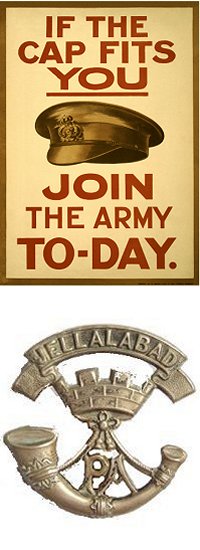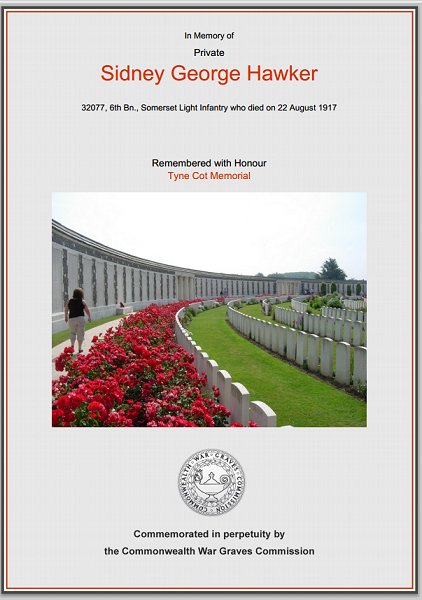yeovil at War
Sidney George Hawker
Killed in action during the Third Battle of Ypres
Sidney George Hawker was born in Norton sub Hamdon in 1886, the son of carter Alfred Hawker (b 1851) and his wife Mary (b 1853). In the 1891 census Alfred and Mary were listed living at Larkhill Lane with their children; Louisa (b 1879), Charles (b 1881), Sidney George, Benjamin Edmund (b 1889) and William Alfred (b 1891). All the children were born in Norton except William who was born in Yeovil. In the 1901 census the family were listed at Brimsmore Cottages and Alfred listed his occupation as a 'Teamster on Farm' while both Charles and 15-year old Sidney were listed as ' Labourer on Farm'. They most likely all worked at adjoining Marlclose Farm. By 1911 the family were living at Brimsmore with Alfred now a labourer on a farm and Sidney working as a 'Gardener (Gentleman's)'.
It is likely that, especially in later life, he was known as George since his name is written as Hawker, G rather than Hawker, SG on the War Memorial in the Borough.
In the winter of 1915 Sidney married Margaret Glover at Yeovil. Sidney and Margaret set up home at 55 South Street.
 It
is not known
when Sidney
enlisted but,
from his Service
No 32077, it was
most likely late
1916. He
enlisted at
Yeovil, joining
the 6th
(Service) Battalion of the
Somerset Light
Infantry.
It
is not known
when Sidney
enlisted but,
from his Service
No 32077, it was
most likely late
1916. He
enlisted at
Yeovil, joining
the 6th
(Service) Battalion of the
Somerset Light
Infantry.
A note in Sydney's Service Record indicates that he was formerly a member of the Devonshire Regiment, Service Number 37684, but unfortunately there are no further details of this part of his military service.
In 1916 the 6th Battalion fought at Delville Wood and Flers-Courcelette in the Battles of the Somme. In 1917 they were involved in The German retreat to the Hindenburg Line, the Arras Offensive and the Third Battle of Ypres.
It is not known what part Sidney played in these great battles but, from the date he went missing in action presumed killed, 22 August 1917, it is known that he took part in the Third Battle of Ypres.
The Regimental History of the Somerset Light Infantry recalls the events of that day "For several days the weather had been fine and warm with a drying wind and as a consequence the battle area was in better condition than in previous operations which had taken place during August. Zero hour for the attack was 7am on 22nd, and at 7:05am, when the Artillery barrage lifted, the two battalions of the 43rd Brigade - 6th Somersets on the right and 6th Duke of Cornwall's Light Infantry on the left - "went over the top." Of the Somersets No 1 Company was on the right, No 4 on the left, No 2 in immediate support, and No 3 formed the last wave. With the exception of a portion of No 4 Company the leading waves reached the edge of Inverness Copsw with only slight casualties. A strong-point at the north-west corner of the Copse had held up a portion of No 4 Company. No 2 Company, detailed for mopping up, also suffered casualties from another enemy strong point about 200 yards west of Fitzclarence Farm; but the point was successfully dealt with, though the defenders fought gallantly enough, the post being in flames, from bombs, when captured. At 8:01am a message was sent back to the Brigade that the post had been taken.
Meanwhile Nos 1 and 4 Companies had pushed on, followed by the remainder of No 2 and No 3 Companies. Small numbers of No 4 reached the objective but without officers. No 1 had heavy fighting round Herenthage Château before it was captured.... Some 60 prisoners were taken here and sent back. In all 130 Germans were sent back from the western edge of the Copse.
About 8:30am Nos 1, 2 and 4 Companies sent back word to battalion headquarters that they had been severely depleted in numbers. The CO therefore pushed No 3 Company up to the eastern edge of Inverness Copse and asked for support from the Brigade and 10th Durham Light Infantry.... A series of messages showing the desperate position in the front line now reached the CO from the OC No 3 Company. These messages are admirably set out in the Battalion narrative of operations and give a clear view of the straits the gallant Somerset men were put to: the messages are given in full as they would loose force if paraphrased.
"9:30am. Arrived at eastern edge of Copse with few oddments, about 70 men in all. We were being surrounded so had been forced to withdraw. Both flanks in air. We must have reinforcements." This was followed by a pigeon message: "9:55am. Have arrived. Strength two platoons east edge of Copse. Am being surrounded so we must fall back. No further supports have arrived." The next message is timed 10:05am "Pushed back from east edge of Copse. More reinforcements required. Lees (10th DLI) unable to give me any more. Am still holding the largest part of Copse."
About 1pm a hostile party of about one hundred Germans marched up the Menin Road and turned south, just where the Château road joined up with the former. Several small parties of the enemy, each of about twenty men, were also seen moving up north and south. Next, a whole battalion of Germans was observed advancing over the ridge east of Inverness Copse. In response to our SOS the guns opened fire and these hostile advances were checked. But again, about 2 pm, the enemy was seen massing in the valley of the Bassevillebeek and some minutes later he was reported "Advancing towards us north of Menin Road, 400 yards in front of our line." Machine-gun, Lewis-gun and artillery fire again checked this advance and dispersed the enemy.... During the night the 6th Somersets and one company of the DLI, who had been holding the front line throughout the whole day, were relieved by the KOYLI and other companies of the Durhams, and moved back to the western edges of Inverness Copse in support. The Somerset men were greatly exhausted. In addition to the attack early in the morning of 22nd, they had had to beat off three counter attacks pressed with vigour. It is impossible to give the numbers of the battalion at this period, but they must have been small, and it was but a remnant which held the western edges of the Copse."
Sidney Hawker was reported missing in action, presumed killed, on this day, 22 August 1917. He was aged 31. This same day, and in the same action, another Yeovil man Val Sutton was killed.
Almost a year later, on 26 July 1918, the Western Gazette reported "Mrs Hawker of 55 South Street, has received the information from the War Office, that her husband, Private Sidney George Hawker, of the Somerset LI, who was posted missing on 22nd of August, 1917, is now presumed to have been killed on that date or since. Enclosed with the sad tidings was a message from the King and Queen."
Sidney George Hawker is commemorated on Panels 41 to 42 and 163a of the Tyne Cot Memorial, West-Vlaanderen, Belgium, and his name is recorded on the War Memorial in the Borough although, as pointed out above, it is recorded incorrectly.
gallery

The Commonwealth War Graves Commission certificate in memory of Sidney Hawker.